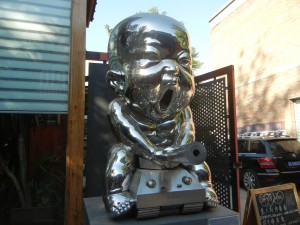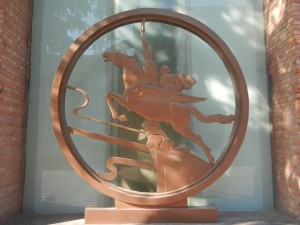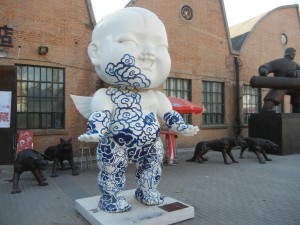Beijing’s thriving modern art scene converged in a big old ugly factory that East Germans built. Artists found it to be a cheap and private place where they could experiment with new ideas and forms. But like many other avant guard hubs around the world (Paris’ Montmartre, New York’s Greenwich Village, and San Francisco’s North Beach and Haight Ashbury), it became a popular tourist destination, and it gentrified.
But its success allows it to be a haven for lots of creative souls. Though 798 features modern artists, many still follow some of China’s most hallowed traditions.
Though the work in the above shot criticizes modern military aggression, the forms of the tank’s rider reflect ancient yin/yang patterns. You don’t see any straight lines or flat planes in him. All his forms are circular, and light and dark colors alternate like yin and yang energies in landscape painting.
The sculpture above also evokes yin/yang patterns with its curving forms within a circle.
And the cloud patterns in the above photo have very deep roots, which were established in the Shang Dynasty, or before, when clouds, wind and rain acquired a wide field of meanings that created a seedbed for many of Chinese culture’s most central ideas.
You can also see ancient Chinese ideas in some of its modern skyscrapers. And many of the greatest American skyscrapers were shaped by ancient and medieval Western art forms.
So, modern art is even cooler than most people think it is–it reflects the ancient past as it questions conventions.
And ancient cultures were more creative than most folks think–their art and ideas still influence our thoughts when we look for new meanings.




Comments on this entry are closed.